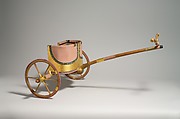Model of a Chariot from the Tomb of Yuya and Tjuyu
Modern
Modern
Not on view
During the New Kingdom, wars were fought by infantrymen armed with bows and arrows, spears, javelins, maces, clubs, slings, and throw-sticks. Close-combat weapons included daggers, axes, and the scimitar, or sickle sword, newly imported from western Asia. The most formidable weapon of the period was, however, the horse-drawn chariot. Comprising a cab with two rear-mounted wheels that was connected by a pole to a yoked team of horses, each chariot was manned by a driver (who also handled a shield) and a warrior. These warriors came from the Egyptian upper classes, and the chariot corps was considered an elite unit.
This model reproduces in reduced scale the chariot excavated from the tomb of Yuya and Tuyu (KV46), the parents of Queen Tiye, who were buried under Amenhotep III (ca. 1389–1349 B.C.). The original was slightly more than eight feet long (245 cm); made of wood and leather, it was probably too light to have been used in combat. Of the six chariots found in the tomb of Tutankhamun, only one was sturdy enough for war or hunting.
Due to rights restrictions, this image cannot be enlarged, viewed at full screen, or downloaded.

